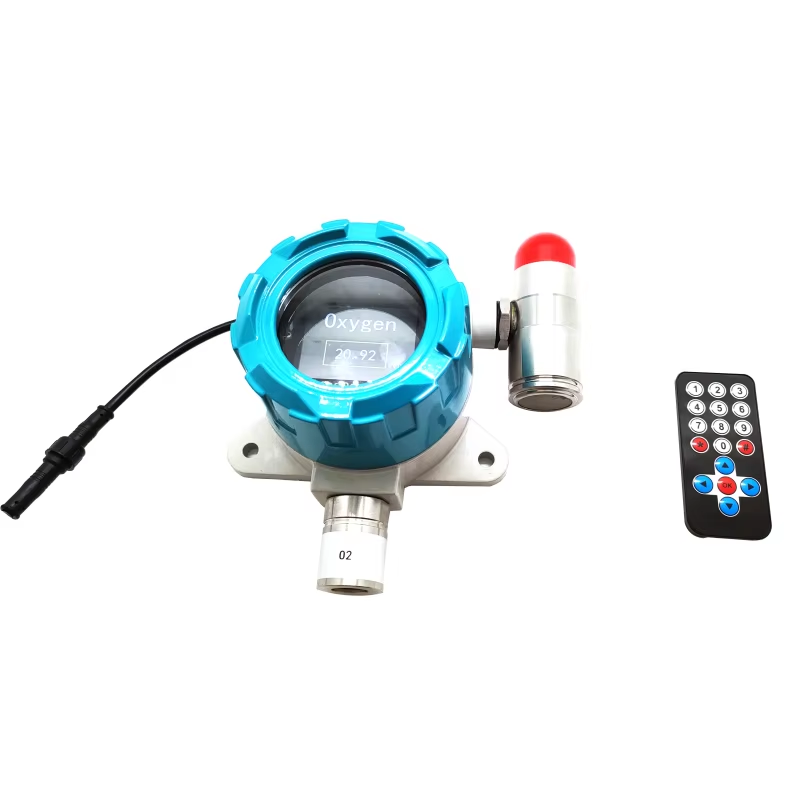The industrial structure of Saudi Arabia is dominated by oil, natural gas, petrochemicals, chemicals, and mining. These industries present significant risks of flammable, explosive, and toxic gas leaks. Therefore, explosion-proof gas sensors are among the most critical front-line components in its industrial safety systems.
Case Background and Core Requirements
- Industry Characteristics: The entire oil and gas supply chain in Saudi Arabia—from upstream drilling and extraction to midstream transportation and refining, and downstream petrochemical production—involves hydrocarbons (methane, propane, VOCs, etc.) and toxic gases (Hydrogen Sulfide H₂S, Carbon Monoxide CO, etc.).
- Environmental Requirements: These areas are typically classified as Hazardous (Explosive) Areas. Any electrical equipment used must have explosion-proof certification to prevent the equipment from becoming an ignition source.
- Regulatory Drivers: Stringent safety standards from the Saudi Arabian Standards Organization and national giants like Saudi Aramco (e.g., Aramco’s SAES standards) mandate the installation of certified gas detection systems in all hazardous areas.
Typical Case: Integrated Gas Detection System at Saudi Aramco’s Jazan Refinery
1. Project Overview:
- Location: Jazan Economic City, Saudi Arabia.
- Facility: The Jazan Refinery is a massive integrated complex for refining, petrochemicals, and power generation.
- Challenge: The facility processes large quantities of high-sulfur crude oil, implying a very high risk of H₂S leaks. Additionally, the entire plant contains numerous flammable gas atmospheres. The high-temperature, high-humidity, high-salinity coastal environment poses severe challenges to equipment durability.
2. Application Scenarios of Explosion-Proof Gas Sensors:
In such a large facility, explosion-proof gas sensors are deployed at hundreds of critical points:
- Pump and Compressor Seals: These rotating equipment are common leak points. Catalytic Bead or Infrared explosion-proof sensors are installed to monitor combustible gases.
- Storage Tank Area (near vents and loading arms): Vapors may be released during product transfer or from “breathing” due to temperature changes. Sensors provide continuous monitoring here.
- Process Unit Areas (e.g., reactors, fractionation columns): Fixed gas detectors are installed at flanges and valve connections where H₂S and combustible gases might be present. These sensors often have Intrinsic Safety (Ex i) certification, meaning they cannot release sufficient energy to cause ignition, even if they fail while powered.
- Sewer and Drainage Systems: These confined spaces can accumulate flammable gases (e.g., methane). Diffusion-type or Pump-assisted explosion-proof sensors are used for monitoring.
- Air Intakes for Control Rooms and Shelters: Sensors are installed at air inlets to these buildings to prevent toxic or flammable gases from being drawn inside, ensuring personnel safety.
3. Sensor Technology and Explosion-Proof Types:
- Technology Principles:
- Combustible Gases: Primarily using Catalytic Bead and Non-Dispersive Infrared technologies. NDIR is increasingly popular in harsh environments due to its immunity to oxygen deprivation and long lifespan.
- Toxic Gases (e.g., H₂S): Primarily using Electrochemical sensors.
- Explosion-Proof Certification: Equipment in Saudi Arabia typically needs to meet international standards (like ATEX, IECEx) and local certification. Common protection types include:
- Ex d [Flameproof]: The enclosure can withstand an internal explosion without damage and prevent the transmission of flame to the external atmosphere.
- Ex e [Increased Safety]: Additional measures are applied to prevent the possibility of arcs, sparks, or excessive temperatures occurring.
- Ex i [Intrinsic Safety]: Safety is ensured by limiting electrical energy in the circuit. This is one of the highest levels of protection, often used for sensors requiring live maintenance in the field.
4. System Integration and Data Application:
These explosion-proof sensors do not operate in isolation but are connected to a plant-wide Gas Detection Control System.
- Real-Time Alarming: When a sensor detects gas concentration reaching a preset alarm level, it triggers audible and visual alarms in the central control room, pinpointing the leak location.
- Automatic Shutdown/Control: The system can automatically initiate emergency procedures, such as:
- Activating ventilation systems in the leak area.
-
- Automatically closing relevant Emergency Shut-Down Valves.
- Stopping nearby pumps or compressors.
- Data Logging and Analytics: All data is logged and analyzed for predictive maintenance (e.g., identifying equipment with frequent minor leaks), optimizing patrol routes, and conducting safety audits.
Challenges and Future Trends
- Environmental Durability: Saudi Arabia’s extreme climate (high temperature, sand, salt corrosion) severely tests the housing materials, sealing performance, and stability of electronic components. Equipment requires a high Ingress Protection (IP) Rating.
- Reducing Total Cost of Ownership: This includes the cost of calibration, maintenance, and sensor replacement. The future trend is toward more stable, longer-lasting technologies (like IR) and smart sensors with self-diagnostic capabilities that can report faults or degradation.
- Smartization and Predictive Maintenance: Integrated with IoT technology, explosion-proof gas sensors are becoming part of Industry 4.0. By analyzing data trends, the system can warn of potential equipment failures before gas concentrations reach dangerous levels, shifting from reactive response to proactive prevention.
- Wireless Explosion-Proof Sensors: For plant modifications or areas where wiring is difficult, the use of certified wireless gas sensors is becoming a flexible and efficient supplementary solution.
- Complete set of servers and software wireless module, supports RS485 GPRS /4g/WIFI/LORA/LORAWAN
- For more gas sensors information,
- please contact Honde Technology Co., LTD.
- Email: info@hondetech.com
- Company website: www.hondetechco.com
- Tel: +86-15210548582
Post time: Sep-23-2025


